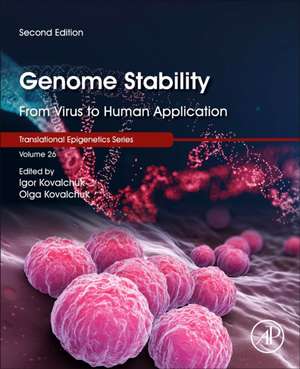Genome Stability: From Virus to Human Application: Translational Epigenetics, cartea 26
Editat de Igor Kovalchuk, Olga Kovalchuken Limba Engleză Paperback – 22 iul 2021
This second edition has been fully revised to address evolving research trends, including CRISPRs/Cas9 genome editing; conventional versus transgenic genome instability; breeding and genetic diseases associated with abnormal DNA repair; RNA and extrachromosomal DNA; cloning, stem cells, and embryo development; programmed genome instability; and conserved and divergent features of repair. This volume is an essential resource for geneticists, epigeneticists, and molecular biologists who are looking to gain a deeper understanding of this rapidly expanding field, and can also be of great use to advanced students who are looking to gain additional expertise in genome stability.
- A deep analysis of genome stability research from various kingdoms, including epigenetics and transgenerational effects
- Provides comprehensive coverage of mechanisms utilized by different organisms to maintain genomic stability
- Contains applications of genome instability research and outcomes for human disease
- Features all-new chapters on evolving areas of genome stability research, including CRISPRs/Cas9 genome editing, RNA and extrachromosomal DNA, programmed genome instability, and conserved and divergent features of repair
| Toate formatele și edițiile | Preț | Express |
|---|---|---|
| Paperback (1) | 940.43 lei 5-7 săpt. | |
| ELSEVIER SCIENCE – 22 iul 2021 | 940.43 lei 5-7 săpt. | |
| Hardback (1) | 720.37 lei 2-4 săpt. | |
| ELSEVIER SCIENCE – 23 sep 2016 | 720.37 lei 2-4 săpt. |
Din seria Translational Epigenetics
- 18%
 Preț: 553.82 lei
Preț: 553.82 lei - 19%
 Preț: 659.12 lei
Preț: 659.12 lei - 23%
 Preț: 1206.43 lei
Preț: 1206.43 lei - 28%
 Preț: 915.82 lei
Preț: 915.82 lei - 24%
 Preț: 519.00 lei
Preț: 519.00 lei - 9%
 Preț: 783.84 lei
Preț: 783.84 lei - 23%
 Preț: 824.68 lei
Preț: 824.68 lei - 26%
 Preț: 949.33 lei
Preț: 949.33 lei - 27%
 Preț: 924.87 lei
Preț: 924.87 lei - 27%
 Preț: 804.68 lei
Preț: 804.68 lei - 27%
 Preț: 919.72 lei
Preț: 919.72 lei - 23%
 Preț: 918.41 lei
Preț: 918.41 lei - 28%
 Preț: 910.33 lei
Preț: 910.33 lei - 24%
 Preț: 956.09 lei
Preț: 956.09 lei - 26%
 Preț: 694.46 lei
Preț: 694.46 lei - 9%
 Preț: 1147.82 lei
Preț: 1147.82 lei - 19%
 Preț: 833.02 lei
Preț: 833.02 lei - 27%
 Preț: 848.75 lei
Preț: 848.75 lei - 24%
 Preț: 846.30 lei
Preț: 846.30 lei - 22%
 Preț: 684.94 lei
Preț: 684.94 lei - 23%
 Preț: 794.89 lei
Preț: 794.89 lei - 24%
 Preț: 799.69 lei
Preț: 799.69 lei - 9%
 Preț: 799.39 lei
Preț: 799.39 lei - 21%
 Preț: 942.98 lei
Preț: 942.98 lei - 25%
 Preț: 727.60 lei
Preț: 727.60 lei - 23%
 Preț: 810.69 lei
Preț: 810.69 lei - 23%
 Preț: 789.43 lei
Preț: 789.43 lei - 23%
 Preț: 791.73 lei
Preț: 791.73 lei - 23%
 Preț: 812.29 lei
Preț: 812.29 lei - 23%
 Preț: 803.71 lei
Preț: 803.71 lei - 27%
 Preț: 967.96 lei
Preț: 967.96 lei - 28%
 Preț: 703.10 lei
Preț: 703.10 lei - 25%
 Preț: 872.39 lei
Preț: 872.39 lei - 29%
 Preț: 827.81 lei
Preț: 827.81 lei - 20%
 Preț: 711.92 lei
Preț: 711.92 lei - 23%
 Preț: 729.96 lei
Preț: 729.96 lei - 23%
 Preț: 805.50 lei
Preț: 805.50 lei
Preț: 940.43 lei
Preț vechi: 1198.23 lei
-22% Nou
Puncte Express: 1411
Preț estimativ în valută:
179.97€ • 186.83$ • 150.07£
179.97€ • 186.83$ • 150.07£
Carte tipărită la comandă
Livrare economică 15-29 martie
Preluare comenzi: 021 569.72.76
Specificații
ISBN-13: 9780323856799
ISBN-10: 0323856799
Pagini: 760
Ilustrații: 300 illustrations (200 in full color)
Dimensiuni: 216 x 276 mm
Greutate: 2.06 kg
Ediția:2
Editura: ELSEVIER SCIENCE
Seria Translational Epigenetics
ISBN-10: 0323856799
Pagini: 760
Ilustrații: 300 illustrations (200 in full color)
Dimensiuni: 216 x 276 mm
Greutate: 2.06 kg
Ediția:2
Editura: ELSEVIER SCIENCE
Seria Translational Epigenetics
Cuprins
1. Genome stability: An evolutionary perspective
Part I Genome instability of viruses
2. Genetic instability of RNA viruses
3. Genome instability in DNA viruses
Part II Genome instability in bacteria and archaea
4. Genome instability in bacteria and archaea: Strategies for maintaining genome stability
5. Genome instability in bacteria: Causes and consequences
6. CRISPR – Bacterial immune system
Part III Genome stability of unicellular eukaryotes
7. From micronucleus to macronucleus: Programmed DNA rearrangement in ciliates is regulated by non-coding RNA molecules
8. Homologous recombination and nonhomologous end-joining repair in yeast
Part IV Genome stability in multicellular eukaryotes
9. Meiotic and mitotic recombination: First in flies
10. Genome stability in Drosophila: Mismatch repair and genome stability
11. Genome stability in Caenorhabditis elegans
12. Plant genome stability—General mechanisms
13. Genetic engineering in plants using CRISPRs
Part V Genome stability in mammals
14. Cell cycle control and DNA-damage signaling in mammals
15. The role of p53/p21/p16 in DNA damage signaling and DNA repair
16. Roles of RAD18 in DNA replication and post-replication repair (PRR)
17. Base excision repair and nucleotide excision repair
18. DNA mismatch repair in mammals
19. Repair of double-strand breaks by nonhomologous end joining; Its components and their function
20. Homologous recombination in mammalian cells: From molecular mechanisms to pathology
21. Telomere maintenance and genome stability
22. Chromatin, nuclear organization and genome stability in mammals
23. Role of DNA mthylation in genome stability
24. Non-coding RNAs in genome integrity
Part VI
Human diseases associated with genome instability
25. Human diseases associated with genome instability
26. Cancer and genomic instability
27. Epigenetic regulation of the cell cycle & DNA-repair in cancer
28. Genomic instability and aging: Causes and consequences
29. The DNA damage response and neurodegeneration: Highlighting the role of the nucleolus in genome (in)stability
Part VII Effect of environment on genome stability
30. Diet and nutrition
31. Chemical carcinogens and their effect on genome and epigenome stability
32. Modern sources of environmental ionizing radiation exposure and associated health consequences
Part VIII Bystander and transgenerational effects: Epigenetic perspective
33. Sins of fathers through a scientific lens: Transgenerational effects
34. Radiation and chemical induced genomic instability as a driver for environmental evolution
35. Transgenerational genome instability in plants
36. Methods for the detection of DNA damage
37. Conserved and divergent features of DNA repair. Future perspectives in genome stability research
38. Off-target effects in genome editing
Part I Genome instability of viruses
2. Genetic instability of RNA viruses
3. Genome instability in DNA viruses
Part II Genome instability in bacteria and archaea
4. Genome instability in bacteria and archaea: Strategies for maintaining genome stability
5. Genome instability in bacteria: Causes and consequences
6. CRISPR – Bacterial immune system
Part III Genome stability of unicellular eukaryotes
7. From micronucleus to macronucleus: Programmed DNA rearrangement in ciliates is regulated by non-coding RNA molecules
8. Homologous recombination and nonhomologous end-joining repair in yeast
Part IV Genome stability in multicellular eukaryotes
9. Meiotic and mitotic recombination: First in flies
10. Genome stability in Drosophila: Mismatch repair and genome stability
11. Genome stability in Caenorhabditis elegans
12. Plant genome stability—General mechanisms
13. Genetic engineering in plants using CRISPRs
Part V Genome stability in mammals
14. Cell cycle control and DNA-damage signaling in mammals
15. The role of p53/p21/p16 in DNA damage signaling and DNA repair
16. Roles of RAD18 in DNA replication and post-replication repair (PRR)
17. Base excision repair and nucleotide excision repair
18. DNA mismatch repair in mammals
19. Repair of double-strand breaks by nonhomologous end joining; Its components and their function
20. Homologous recombination in mammalian cells: From molecular mechanisms to pathology
21. Telomere maintenance and genome stability
22. Chromatin, nuclear organization and genome stability in mammals
23. Role of DNA mthylation in genome stability
24. Non-coding RNAs in genome integrity
Part VI
Human diseases associated with genome instability
25. Human diseases associated with genome instability
26. Cancer and genomic instability
27. Epigenetic regulation of the cell cycle & DNA-repair in cancer
28. Genomic instability and aging: Causes and consequences
29. The DNA damage response and neurodegeneration: Highlighting the role of the nucleolus in genome (in)stability
Part VII Effect of environment on genome stability
30. Diet and nutrition
31. Chemical carcinogens and their effect on genome and epigenome stability
32. Modern sources of environmental ionizing radiation exposure and associated health consequences
Part VIII Bystander and transgenerational effects: Epigenetic perspective
33. Sins of fathers through a scientific lens: Transgenerational effects
34. Radiation and chemical induced genomic instability as a driver for environmental evolution
35. Transgenerational genome instability in plants
36. Methods for the detection of DNA damage
37. Conserved and divergent features of DNA repair. Future perspectives in genome stability research
38. Off-target effects in genome editing
Recenzii
"This book provides a comprehensive overview of genome stability that should be of great interest to any researcher within this area of expertise." --The Quarterly Review of Biology, Vol.92, No. 4


